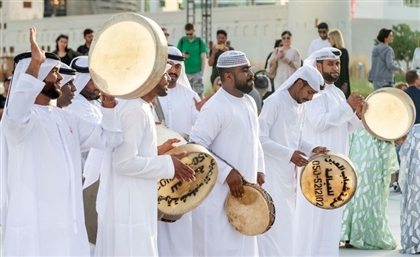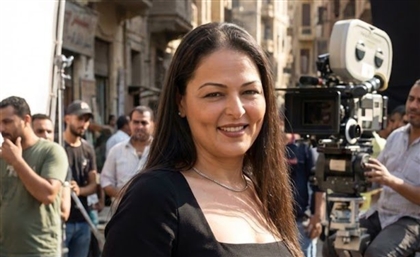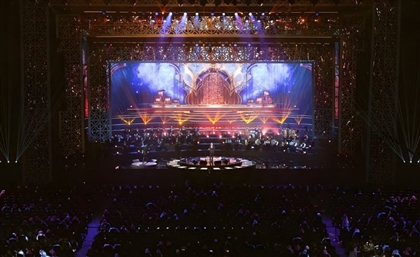Bethazaryyyy: On New Cairo’s Distinct Social Dialect
We speak with Dr. Eman Youssri, a voice print expert and author of the paper 'Perception of English Intonation by Egyptians', to discuss a social dialect emerging in New Cairo.

In New Cairo, the soundscape is unique. It is a place where Egyptian youth speak with a linguistic rhythm that might raise eyebrows elsewhere, one in which English and Arabic intermingle fluidly, where vowels and consonants are elongated and certain words drawn out in a spoken texture that doesn’t belong to either language but rather reflects a new emerging sociological identity.
"Bthazzarrrrrrryyyy, it was soooooo nicee!" The word 'bthazzarrryyy', which in Arabic would typically be crisp and short, becomes drawn-out and almost melodic as a result of the intonation patterns transfer. But what does this mean exactly? And what does it imply about the way they've learned, and chosen, how to speak?
To understand this phenomenon, we speak to Dr. Eman Youssri, a voice print expert specialising in linguistics, academic researcher, and author of the paper 'Perception of English Intonation by Egyptians'.
“It’s not just about code-switching from English to Arabic and vice versa, or borrowing vocabulary from English," Dr. Eman Youssri explains. "It’s the rhythm, the cadence, and the deliberate manipulation of vowels and consonants in both languages that gives this new dialect its distinct flavour.” The term “intonation transfer” may apply here, albeit with a caveat. First, let’s define “intonation transfer”: it means that the intonation patterns of the first language (L1, or Mother Tongue) of a speaker is applied to their second language (L2), in the context of learning and acquiring a second language. This transfer can affect the pronunciation’s clarity and naturalness of the speaker’s speech. Thus, in the case of Arabic being spoken with English-like melodic patterns in New Cairo, the speakers in this case are already Arab, and their L1 or Mother Tongue is Egyptian Colloquial Arabic. “They speak Egyptian Colloquial Arabic with English intonation pattern, according to their exposure to English language at international schools from an early age,” Dr. Youssri explains. “This exposure influences not only their vocabulary but also their linguistic patterns, particularly how they produce speech.”
Education systems that emphasise English, especially those aligned with Western curricula, teach students the nuances of English, the "music" of the language. However, despite this deep immersion in English, many students don’t speak proper British or American English. This discrepancy happens because the version of English they learn is often a globalised, hybridised form rather than a strict adherence to any single accent or standard. Therefore, the speech reflects a blend of local vernacular, global influences, and personal identity rather than the formalised British or American norms. In this context, intonation transfer occurs as a result of early exposure to English prosody.
English has a distinctive prosodic structure compared to Arabic, with a more varied pitch that signals emphasis, emotional tone, and syntactical structure. English speaking patterns are shaped by rhythm, stress, intonation and pitch, which together define the language's flow and meaning. It is also a stress-timed language, where certain syllables are emphasised, such as in the word “banana” (stress on the second syllable). Content words like “book” and “run” are stressed, while function words like “the” and “in” are unstressed.
In Cairene Egyptian Arabic, nearly every phonological word - the smallest pronounceable unit in a sentence - carries a pitch accent. This means each word has its own mini rise and/or fall in pitch, creating a dense melodic rhythm. According to researchers Chahal and Hellmuth, the most common accent shape is called L+H*, which starts low (L) and rises to a high target (H) on the stressed syllable. When New Cairo youth adopt English-like intonation, they sometimes reduce the number of accents or change the pitch shapes, giving their speech a noticeably different cadence.
In Egyptian Arabic, both continuation phrases (when you’re not finished speaking yet) and yes–no questions end with a rising pitch, notated by linguists as (high-high) H-H% - that means the voice stays high (H) and then ends high (H%) at the very end of the phrase. But the two are still different: yes–no questions have a steeper rise throughout the whole sentence, whereas continuation rises keep the pitch more level until the final word.
By contrast, English yes–no questions usually keep pitch steady or falling until just before the last word, where they make a sharp rise (“Are you coming ↗?”). When New Cairo speakers use that English-style rise pattern in Arabic, it changes the feel of the question - it can sound more informal, playful, or even slightly ironic. In Egyptian Arabic, a rising contour conventionally signals uncertainty or incompletion; to end on such a rise is to suggest that more is to come. But in English, the sharp final rise often marks a simple yes–no query, a cue that requires no further elaboration.
When these same individuals speak Arabic, they don’t merely translate English words directly; instead, they bring English-like intonation patterns with them. This results in a hybrid speaking style, where Arabic words are delivered with English-like intonation. When someone says "The food was sooo good!" in Arabic, they may elongate the word “Toooohfaaaa”, mimicking an English-style emphasis.
In Egypt’s sharply stratified society, class performance often extends to language. As Pierre Bourdieu observes, linguistic forms carry social value, and mastering them is an investment in symbolic capital. And according to William Labov’s studies of linguistic stratification, even small shifts in pronunciation can serve as indicators of class identity. “I prefer to describe it as a sociolect, because it is related to a specific social class till now. Rather, it used to indicate that the speaker belongs to a specific social class,” Dr Youssri says.
The social dialect of New Cairo, like many urban centres in the global South, reflects the complex social hierarchies at play; the rise of this dialect among youth as a dominant feature of speech is deeply intertwined with social class. For those living in Cairo's new gated communities, it is a performance of status spread in part through linguistic mimicry. Its association with higher education, and modernity, marks the speaker as part of the upper-middle class, one that is striving to claim a position in an increasingly globalised, stratified Egypt.
In societies marked by stark class divisions like Egypt’s, even lower-income groups engage in "class performance," where the conscious use of elite speech patterns becomes a tool for asserting status. The desire for upward mobility leads to the internalisation of elite markers, even in the absence of material wealth. This “linguistic marking” creates a clear social boundary between those who can perform this linguistic act and those who cannot.
- Previous Article Central Bank of Egypt Cuts Interest Rates by 2% as Inflation Slows
- Next Article Six Unexpected Natural Wonders to Explore in Egypt
Trending This Week
-
Dec 16, 2025



























